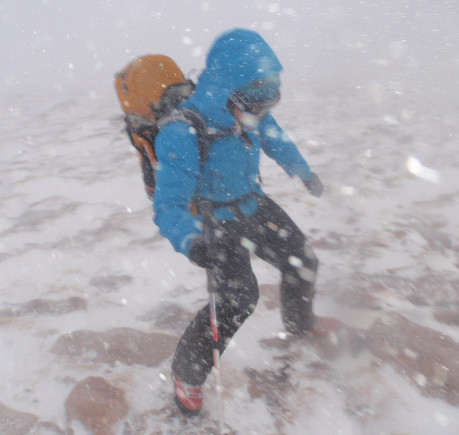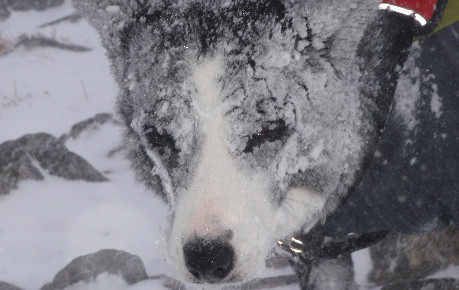Wind is the only ‘show-stopper’ in the hills. It can rain, snow, shine, be minus 10, plus 20, clear or foggy - none of those things are going to physically stop you on the hill or seriously hinder your progress. But wind can – and does, on a regular basis, particularly during the winter months. Below are a few thoughts and facts from Heather Morning - Mountaineering Scotland's former Senior Mountain Safety Advisor and now Chief Instructor at Glenmore Lodge - to ensure that you use the wind to your advantage and help you understand how those wind speed numbers on mountain weather forecasts relate to the physical impact on you out on the hill.
The first thing I look for on the mountain weather forecast is the wind direction and speed to ensure that I use the wind to my advantage. For example, if the wind is forecast to come from the south-west, then I want to ensure that when I am on the exposed higher ground I have the wind behind me, helping me along, rather than hindering progress. This is particularly important if precipitation is also forecast, as it’s extremely unpleasant with rain or snow lashing in your face carried on a 30 miles per hour (mph) wind. Far better to have the weather on your back. In addition, battling into a strong wind is very energy-sapping and exposure to wind will be a significant factor in the onset of hypothermia.
Take a look at the table below to check out how different wind speeds will affect progress and balance and remember that wind will always increase with altitude so it’s a good idea to check the mountain-specific forecasts which will give detail of wind speed at different altitudes. The new Met Office Mountain Forecast launched in 2017 will provide both the gust and the average (mean) speed in mph at 300, 600, 900 and 1100 meters above sea level.
It is worthy of note that the highest wind speed recorded at the summit weather station on Cairngorm at the time of writing was an eye-watering 176 mph!
High winds don’t mean you have to miss out on your day on the hill, but it might mean that you change your plans. Take a lower route or more grassy ‘roly-poly’ hill where being blown off balance is unlikely to cause you injury.

Photo: Duncan Gray
Less than 20
Negligible
Unlikely to affect your balance, but be aware that wind chill will be a factor.* A temperature of 0 degrees will be equivalent to -10 degrees. Add a windproof outer layer. Secure map and compass. Goggles will be very useful in winter conditions.
Starts to affect the balance of a fit/strong adult. You may find that your foot does not quite land where you had planned it to. May be wise to avoid exposed ridge lines, rough underfoot terrain and keep away from exposed edges. Risk of frost nip** on exposed flesh if the temp is below zero.
40-50
Walking will be arduous. You will need to brace/lean into wind, and energy output will be significantly increased. Risk of being blown off balance/sideways. Navigation will be challenging: get your back to the wind and down on one knee to ensure a stable platform to read your map, then put your map safely away in a pocket.
50-60
Walking will be VERY challenging and exhausting. Keep a wide stance, perhaps linking in arms with a weaker member of the party. Move between gusts and brace yourself when a gust arrives. Get off the hill by the easiest and safest route staying well away from ridge crests and corrie rims.
60-70
Attempting to walk in 60-70mph winds is dangerous, and there is a high risk of being blown over and suffering injury. Stay away from difficult underfoot conditions or exposed edges and get off the hill as soon as possible.
70+
You’re having a laugh! Seriously though, folks, if you are seeing a wind speed of 70 mph or more on the mountain forecast, this is the time to head for a walk in the glen. If you do get caught out in this strength of wind, go with the wind, avoid exposed ridges/corrie rims, link arms. You may even have to resort to crawling to get across a particularly exposed section and get down to a more sheltered area as quickly as you can. I have been physically picked up and thrown several meters by the wind on the Cairngorm Plateau, fortunately with no serious consequences.
*Wind chill is often referred to as the ‘feels like’ temperature and is the temperature that we feel, instead of the actual air temperature that we see shown on weather forecasts. Wind chill factor takes into account wind speeds and humidity to assess how the human body actually feels temperature.
** Frost nip is the reversible freezing of superficial skin layers that is usually marked by numbness and whiteness of the skin. It is most common around the cheekbone area at the edge of your goggles or the tip of your nose.

Dogs may have four legs and a lower centre of gravity, but their lighter weight makes them susceptible to strong winds and vulnerable to spindrift flying close to the ground - so spare a thought for them too.
With thanks to Nic Bullivant (retired Cairngorm Ranger) for his help with this article.